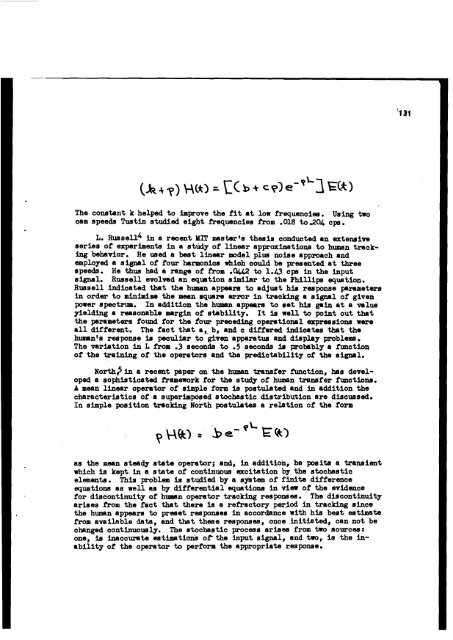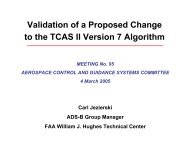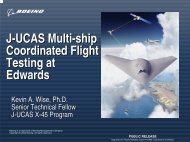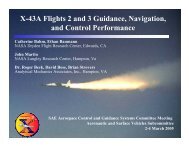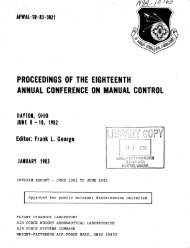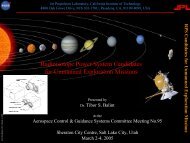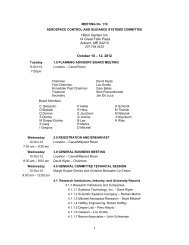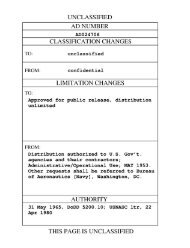Report of the Second Piloted Aircraft Flight Control System - Acgsc.org
Report of the Second Piloted Aircraft Flight Control System - Acgsc.org
Report of the Second Piloted Aircraft Flight Control System - Acgsc.org
Create successful ePaper yourself
Turn your PDF publications into a flip-book with our unique Google optimized e-Paper software.
The constant k helped to improve <strong>the</strong> fit at low frequenciee. Using tuo<br />
cam apeeda Tuatin studied eight frequencies from .018 to204 cp.<br />
L. ~uesell~ in a recent MIT meatarts <strong>the</strong>sis conducted an eate~ive<br />
series <strong>of</strong> experiments in a stdy <strong>of</strong> linear approximatione to human tracking<br />
behavior. He used a beet linear model plue noise approach and<br />
employed a signal <strong>of</strong> four harmonica whioh odd be presented at three<br />
speeds. He thus had a range <strong>of</strong> from .Q442 to 1.43 cp in <strong>the</strong> input<br />
signal. Russell evolved an eqmtion similar to <strong>the</strong> Phillip equation.<br />
Russell indicated that <strong>the</strong> husrpn appears to adjust hia response parameters<br />
in order to minimiru, <strong>the</strong> meen square error in tracking a signal <strong>of</strong> given<br />
power epectrwn. In addition <strong>the</strong> humen appeera to set hla gain at a value<br />
yielding a reasonable margin <strong>of</strong> stability. It is well to point out that<br />
<strong>the</strong> parameters found for <strong>the</strong> four preceding operationel ~preseiona were<br />
all different. The fact that a, b, and c differed indicates <strong>the</strong>t <strong>the</strong><br />
human's response ia peculiar to given apparatus and display problem.<br />
The variation in L from .3 eeconda to .5 seconds is probebly a function<br />
<strong>of</strong> <strong>the</strong> training <strong>of</strong> <strong>the</strong> operators and <strong>the</strong> predictability <strong>of</strong> <strong>the</strong> signal.<br />
North? in a reoent paper on <strong>the</strong> humen transfer Function, he8 developed<br />
a sophisticated framework for <strong>the</strong> study <strong>of</strong> human transfer functions.<br />
A mean linear operator <strong>of</strong> simple form is postulated and in addition <strong>the</strong><br />
cbracteristice <strong>of</strong> a superimpdeed stochastic distribution are discussed.<br />
In simple position treickfng North postulates a relation <strong>of</strong> <strong>the</strong> form<br />
as <strong>the</strong> mean steady state operator; and, in addition, he posits a treneient<br />
which is kept in a state <strong>of</strong> continuoue excitation by <strong>the</strong> stochastic<br />
elements. This problem is studied by a epstem <strong>of</strong> finite difference<br />
equations as well as by differential equations in vim <strong>of</strong> <strong>the</strong> evidence<br />
for discontinuity <strong>of</strong> human operator tracking responses. The discontinuity<br />
arises from <strong>the</strong> fact that <strong>the</strong>re ia a refractory per,iod in tracking since<br />
<strong>the</strong> human appears to prseet reaponsee in accordance with his beet esthate<br />
fro@ available data, and that <strong>the</strong>se responses, once initiated, can not be<br />
cksnged continuously. The stochastic process arises from two sources8<br />
one, is inaccurate eathatid <strong>of</strong> <strong>the</strong> input signal, and two, is <strong>the</strong> inability<br />
<strong>of</strong> <strong>the</strong> operator to perform <strong>the</strong> appropriate response.


